

» Blog Archive The Nudge Unit: changing behaviour the sly way. The internet is alight with blogs and articles about economic nudging, David Cameron’s ‘Nudge Unit’ and yet another economist (Richard Thaler) who’s recruited himself into the White House with promises to improve the effectiveness of government.
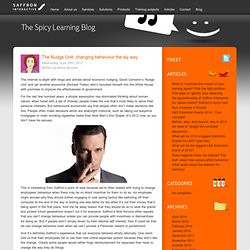
For the last few hundred years, a simple assumption has dominated thinking about human nature: when faced with a set of choices, people make the one that’s most likely to serve their personal interests. But behavioural economists say that people often don’t make decisions like this. People often make decisions which are downright irrational, such as taking out subprime mortgages or chain smoking cigarettes faster than Mad Men’s Don Draper (it’s 2012 now, so you don’t have his excuse). Designing e-Learning for Maximum Motivation Kit Download. This kit includes a pre-recorded webinar and white paper on creating motivating e-learning by Ethan Edwards, chief instructional strategist at Allen Interactions.
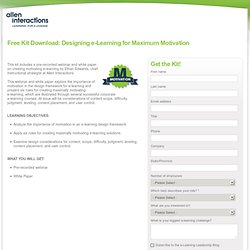
This webinar and white paper explore the importance of motivation in the design framework for e-learning and present six rules for creating maximally motivating e-learning, which are illustrated through several successful corporate e-learning courses. At issue will be considerations of content scope, difficulty, judgment, leveling, content placement, and user control. Analyze the importance of motivation in an e-learning design framework. Apply six rules for creating maximally motivating e-learning solutions.Examine design considerations for content, scope, difficulty, judgment, leveling, content placement, and user control.
Pre-recorded webinarWhite Paper. Marc My Words: eLearning Myths, Part 1 by Marc J. Rosenberg. “Investing in the latest and greatest technology at the expense of investments in quality content and programming may be counterproductive; try for a better balance between the two.”

“Myth (n): a notion based more on tradition or convenience than on fact.” — American Heritage Dictionary There’s a lot we know about eLearning, much based on fact and experience, but we base some of what we believe more on wishful thinking, tradition, and legend. Separating the two can be a helpful exercise, but it can also be controversial, as people will disagree on what is true and what is myth.
Marc My Words: eLearning Myths, Part 1 by Marc J. Rosenberg. Emphasizing Noteworthy Content in eLearning. By Shelley A.
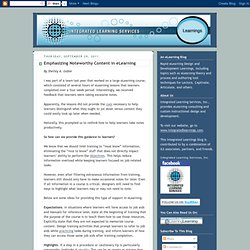
Gable I was part of a team last year that worked on a large eLearning course, which consisted of several hours of eLearning lessons that learners completed over a four-week period. Interestingly, we received feedback that learners were taking excessive notes. Apparently, the lessons did not provide the cues necessary to help learners distinguish what they ought to jot down versus content they could easily look up later when needed. Engaging Learning.
The Ten Commandments of eLearning. » 3 simple tips for setting up online communities Learning in the Social Workplace. On Wednesday I spoke at the World Of Learning 2011 conference in the session on Harnessing the potential of social learning.
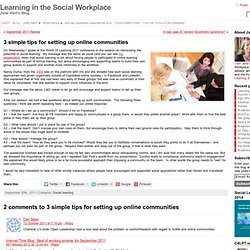
My message was the same as usual (and you can see my presentation here) that social learning is not about forcing people to participate in online learning communities as part of formal training, but about encouraging and supporting teams to build their own group spaces to support one another more informally in the workflow Nancy Ouma, from the VSO was on the platform with me and she showed how such social learning approaches had grown organically outside of mandated online courses – in Facebook and LinkedIn. She explained that at first she had been very wary of these groups, but was now so convinced of their value for volunteers, that she wanted to support more initiatives of this kind. Our message was the same, L&D needs to let go and encourage and support teams to set up their own groups. Q1 – Where do I set up a community? Q3 – How should I manage the group?
Adobe Captivate. The Rapid eLearning Blog. Creating great interactive learning experiences requires a few core building blocks: relevant content, pull versus push, and real-world decisions.
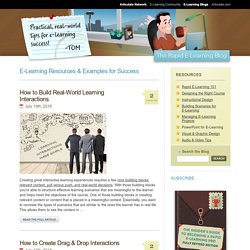
With those building blocks you're able to structure effective learning scenarios that are meaningful to the learner and helps meet the objectives of the course. One of those building blocks in creating relevant content or content that is placed in a meaningful context. Essentially, you want to recreate the types of scenarios that are similar to the ones the learner has in real life. This allows them to see the content in ... Read the full article. Screencasts by elearning. Elearning Tips. What Instructional Designers Do-Updated. What is instructional design?
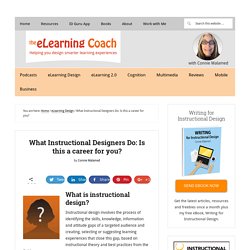
Instructional design involves the process of identifying the skills, knowledge, information and attitude gaps of a targeted audience and creating, selecting or suggesting learning experiences that close this gap, based on instructional theory and best practices from the field. Learnlets. Cathy Moore - ideas for instructional design and elearning. E-Learning Heroes.
Fun e-learning? #LCBQ. Gaming. Upside Board Game Exercise – Download the Winning Game. Tools for Developing Augmented Reality Applications. Software. Social learning. Instructional design for scenarios: sample and useful tool. Branching scenarios can be a pain to design.
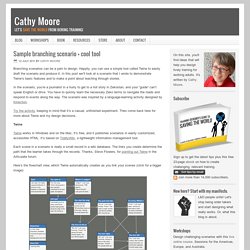
Happily, you can use a simple tool called Twine to easily draft the scenario and produce it. In this post we’ll look at a scenario that I wrote to demonstrate Twine’s basic features and to make a point about teaching through stories. In the scenario, you’re a journalist in a hurry to get to a hot story in Zekostan, and your “guide” can’t speak English or drive. You have to quickly learn the necessary Zeko terms to navigate the roads and respond to events along the way. The scenario was inspired by a language-learning activity designed by Kinection. Try the activity, keeping in mind that it’s a casual, unfinished experiment. Twine Twine works in Windows and on the Mac, it’s free, and it publishes scenarios in easily customized, accessible HTML. Each scene in a scenario is really a small record in a wiki database. Here’s the flowchart view, which Twine automatically creates as you link your scenes (click for a bigger image): Visual design P.S.
20 Tips to Get Started With Your First E-learning Project. This is my first post for this year.

I have not been able to blog due to lot of changes that’s been happening in my professional life. Anyways, here I come, once again, to share the little knowledge that I have. This blog post is for those venturing into custom e-learning business or people who are getting started with their first e-learning project. Before I get into the crux of this post, I would like to explain why I decided to write on this topic. When you are trying to do something for the first time, there is always lot to learn and do before you actually get successful.